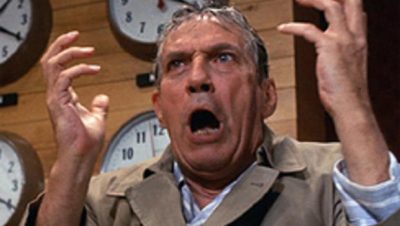
The story of the New York State Historical Association (NYSHA) remains a fluid one with continuing new developments. To recap, in the spring of 2017, NYSHA recast itself as the Fenimore Art Museum and Farmers’ Museum. The change has led to questions regarding the statewide functions it once had and which have diminished over the years. In my post on the subject on November 26, I called for the need for state advocacy for local and state history, an effort which needs to happen in the absence of NYSHA performing that role.
A READER TRACES THE DECLINE OF NYSHA
A comment on my post emphasized the distress felt over the decline of NYSHA:
Successive administrations at NYSHA and the Farmer’s Museum have managed to slowly obliterate a once world class historical association, through antipathy, mission creep, or outright neglect. Stephen C. Clark Sr. and Louis C. Jones pulled off quite the coup when they brought NYSHA from Ticonderoga. With the help of Dixon Ryan Fox, Edward P. Alexander, and Clifford Lord it made huge advances. In the last few decades we have seen fundamental aspects of the organization they helped build decline and eventually fade away entirely. The educational program for schools, the Young Yorkers was a great vehicle for promoting NY State history in schools, as well as ensuring visitation to the museums throughout the school year. It built relationships with NY youth that built appreciation for NY’s history and gave them a vested interest in the organization. The Seminars on American Culture brought people from all over to Cooperstown experience history first hand and learn more about their past. The New York History quarterly was a first class publication and invaluable to both professional historians and amateurs alike. Wendell Tripp’s contribution to the production of that publication was yeoman’s work and he deserves recognition for his years of work on it.
Now it is all gone, a legacy squandered by later generations. In a few years no one will really remain who remembers what the organization once was. It is ironic that an organization based on the preservation of history has forgotten its own.
Someone needs to write the history of NYSHA before everyone is gone and the lessons of its decline are lost to the ages.
FENIMORE ART MUSEUM PRESIDENT RESPONDS TO MY POST
Also in response to my post and the charges brought against by the New York Academy of History (NYAH), Paul D/Ambrosio, the President and CEO of the two museums sent me an email which he asked me to post. I did so on November 30. Here is what has happened since then.
FENIMORE ART MUSEUM FUNDING LETTER
At approximately the same time of these posts, the museums sent out a funding letter under Paul’s name. Certainly that seems like a routine occurrence especially for this time of year. One recipient of the letter who read it at the same time as reading the two posts here, then wrote me:
I find it strange that in the fund raising appeal letter there is no mention of either NYSHA or Research Library…. On this donation form one can chose to make a donation between the Fenimore Art Museum, The Farmers’ Museum or Both! In prior years there has been a third choice for donations, that of The Research Library.
In Paul’s email to me which was posted, he wrote:
We continue to operate our Research Library, a vital resource for the region with more than 100,000 volumes and a large collection of unique original manuscripts.
The recipient of the funding appeal asked, “how certain is he of that figure? Perhaps he has forgotten that the library collection has been significantly reduced?” I can’t speak to the specifics on the format of the funding letters in previous years or the state of research library today compared to years ago. Who does know what happened?
STATUS OF NEW YORK HISTORY JOURNAL AND THE NYS HISTORIAN
In his email which I posted, Paul also commented on the status of New York History, the academic journal for scholarship on New York State history. In the New York History Blog on April 2 reporting on the changed name, Paul is reported as saying that no decision has been made on whether the Fenimore Art Museum will support the journal New York History beyond 2017. In his email to me, Paul wrote:
Please know as well that we are committed to ensuring the continued publication of the journal New York History, and that its future is not in jeopardy.
I posted this on November 30 to the IHARE website, a couple of days after receiving the email from Paul. By coincidence, on November 30, Jeff Pressman, the Chair of the Trustees of Fenimore Art Museum, announced that the concern for the fate of New York History could now be put to rest. Effective January 2019, responsibility for the journal would be transferred from the Fenimore Art Museum to the New York State Museum. Specifically, Devin Lander, the New York State Historian would henceforth be responsible for the publication of the academic journal working in conjunction with Cornell University Press.
Just as the Fenimore Art Museum has the right to focus on its mission as an art museum, so too it has the right to discharge its statewide responsibilities. It use to run the annual state history conference; that task was transferred to Bob Weibel when he was the state historian. When he left, there was no one to do the job. One presumes that the new state historian will assume responsibility for that conference in 2018 just as he will for the journal in 2019. With a podcast on state history also under consideration, one certainly hopes that state historian position will have the resources it needs to fulfill its responsibilities.
STATUS OF NEW YORK STATE HISTORY PRIZES
One other area of statewide activity by NYSHA which I have not seen reported on is history prizes alluded to in one of the replies I received. According to the Fenimore Museum website,
The Dixon Ryan Fox Prize is presented each year to the best unpublished, book-length monograph dealing with some aspect of the history of New York State. The New York State Historical Association named the award for its former president Dixon Ryan Fox in 1997 to recognize his contributions to New York state history. The prize consists of a $3,000 purse. Manuscripts may deal with any aspect of New York State history. Manuscripts may not have been accepted for final publication at the time of submission to the New York State Historical Association. Biographies of individuals whose careers illuminate aspects of the history of the state are eligible, as are manuscripts dealing with such cultural matters as literature and the arts, provided that in such cases the methodology is historical. Works of fiction and works of article length are not eligible.
Deadline for submissions is March 1, 2017. There are no application forms. For submissions, please send an electronic, printable file of the full manuscript, table of contents, and an abstract as separate PDF files to publications@nysha.org. No hard copies are accepted.
Questions? Please contact Martha Membrino in the Publications Department at the New York State Historical Association at publications@nysha.org or by phone at 607-547-1416.
For more information about NYSHA and the prize, please visit our website at https://www.nysha.org/publications/history_prizes/dixon_ryan_fox_manuscript_prize
According to New York History Blog on April 2, the editorial board was scheduled to meet in June to decide the awards for 2017, which would be presented at the Fenimore Art Museum’s annual meeting in July. The same applies to The Paul S. Kerr History Prize, awarded annually to the best article published in New York History. There is no listing on the Fenimore Art Museum website for a winner of the $1000 award in 2017, the last entry is 2016. I also was unable to access the website for the Dixon Ryan Fox award listed in the notice above. When attempting to do so I received the reply
The connection has timed out
and I saw no listing for this award on the Fenimore Art Museum website. The current status of these two history awards remains unclear.
It should be noted that the Fenimore Art Museum does contain historical items. On December 5, it issued a press release:
FENIMORE ART MUSEUM AWARDED TWO GRANTS FROM THE ROBERT DAVID LION GARDINER FOUNDATION SUPPORTING NEW BOOK AND WORKSHOPS ABOUT THE FAMED HAMILTON-BURR LETTERS.
The grants will provide funding for new programs and a publication based on the museum’s collection of documents pertaining to the life and death of founding father, Alexander Hamilton, focusing predominantly on a collection of thirty-five letters exchanged between Hamilton and Aaron Burr, leading up to their fatal duel on July 11, 1804. These documents, although familiar to historians, have remained largely unknown to the public until recently when they were brought to light in the song “Your Obedient Servant” from the hit Broadway musical Hamilton.
The Fenimore plans to design a virtual gallery of the Hamilton-Burr Collection and offer four programs. Two of these programs, for professionals of small historical societies and libraries with archival collections in Suffolk County, will use the printed publication and digitization of the Hamilton-Burr duel letters as a case study. For teachers, the museum will provide lesson plans for inclusion on its free, online educational portal, Harvest of History, and offer two online distance learning sessions exclusively to social studies teachers in Suffolk County as a means to support and encourage active use of these dynamic resources in the classroom.
The press release also notes the continued support for the New York State History Day school program.
At this point, there is really no reason to pursue the fate of the NYSHA any further. As Professor Lisa Keller of the New York Academy of History and the New York History journal put it in her comment in response to my post:
NYSHA no longer exists. It was vaporized when Paul D’Ambrosio moved his $50 million endowment meant for New York history to his non- New York history art museum.
The Fenimore Art Museum and Farmers’ Museum will continue to function as museums serving those specific niches. The statewide activities including the state history conference and state journal will pass to the New York State Historian. The history awards may fall by the wayside unless the State Historian office can pick up the tab or some other arrangement is made. Exactly where the Regents and its Museum Advisory Council are in all this is not clear. The good thing is these changes move to a more robust New York State Historian office; the downside is it still leaves the New York State history community rudderless without a venue or vehicle through which to advocate for New York State history.







